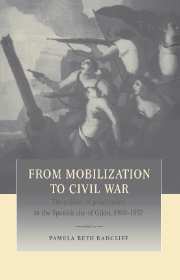Book contents
- Frontmatter
- Contents
- List of maps
- List of tables
- Acknowledgments
- Glossary of terms and abbreviations
- Introduction
- 1 A turning point: the city in 1900
- PART I Patterns of life in working-class Gijón
- 2 The structural context: economy, demography and urban space, 1900–1936
- 3 Culture and community in working-class Gijón
- PART II Institutional forces of opposition: republicans and anarchosyndicalists
- PART III Defining an oppositional culture: the struggle over the public sphere
- PART IV The urban battlefield: conflict and collective action, 1901–1936
- Conclusion
- Appendix 1 Wage and price movement
- Appendix 2 Occupations by status category
- Appendix 3 Supplementary tables
- Select bibliography
- Index
2 - The structural context: economy, demography and urban space, 1900–1936
Published online by Cambridge University Press: 31 October 2009
- Frontmatter
- Contents
- List of maps
- List of tables
- Acknowledgments
- Glossary of terms and abbreviations
- Introduction
- 1 A turning point: the city in 1900
- PART I Patterns of life in working-class Gijón
- 2 The structural context: economy, demography and urban space, 1900–1936
- 3 Culture and community in working-class Gijón
- PART II Institutional forces of opposition: republicans and anarchosyndicalists
- PART III Defining an oppositional culture: the struggle over the public sphere
- PART IV The urban battlefield: conflict and collective action, 1901–1936
- Conclusion
- Appendix 1 Wage and price movement
- Appendix 2 Occupations by status category
- Appendix 3 Supplementary tables
- Select bibliography
- Index
Summary
Structural phenomena can no longer be relied on to predict political formations, as the debate over “exceptionalisms” has demonstrated the variety of possible responses to the development of capitalism and industrialization. Nevertheless, the lack of deterministic links does not mean that no links exist. The specifics of structural evolution in each city, region or country provide a material context that the political discourse must take into account. At some level, this discourse has to formulate a response to that environment, not the only response, but one possible response. This is not to say that economic development is the base, while all else is flimsy superstructure; it is simply a recognition that the material structure of life is one of the factors that shapes the lived experience of people. Moreover, its impact differs among groups of people, depending on gender, occupation, residence and so on. In the broadest sense, then, the structural context is part of the fabric out of which people's lives are constructed, and out of which they construct their lives.
Although the unit of analysis here is the city, Gijón's economic structure must be placed against the background of the larger Spanish picture. Historians still disagree on many of the fundamental characteristics of economic development in the nineteenth and early twentieth centuries, but all agree that the country's industrial transformation was slower and more uneven than in the majority of the western European countries. It began the process with the early industrializers, but fell further behind over the course of the nineteenth century.
- Type
- Chapter
- Information
- From Mobilization to Civil WarThe Politics of Polarization in the Spanish City of Gijón, 1900–1937, pp. 62 - 86Publisher: Cambridge University PressPrint publication year: 1997



